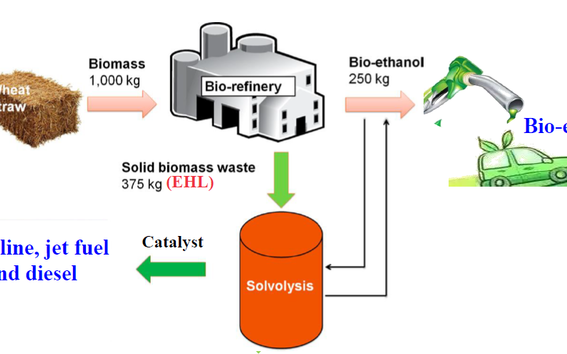Renewable fuel made from biorefinery residues

Notwithstanding recent inroads concerning the electrification of our roads, seas and even skies, the internal combustion engine will not disappear anytime soon. Cleaner burning and more sustainably produced transport fuels need to be developed to achieve the targeted carbon neutral EU by 2050. EHLCATHOL consortium targets the automotive and aviation markets, thereby utilizing lignin, a left-over of pulp mills and biorefineries, as a feedstock.
By far the most consumed renewable transport fuel globally is ethanol. A recent study by E4Tech, a consultancy, forecasts that, in the EU alone, total production capacity for cellulosic ethanol, a variant produced from non-edible biomass, will be in excess of 2 million metric tons by 2030. Such activity will necessarily yield a comparable amount of so-called enzymatic hydrolysis lignin (EHL). To date, lacking more attractive market outlets, nearly all EHL is burnt onsite for heat and electricity. Burning feedstock in an internal combustion engine generally yields a 10-fold or even greater value increase over burning the same in a furnace or boiler. Recognizing this value gap, EHLCATHOL sets out to convert EHL, by means of innovative catalytic process, into lignin crude, which will be further refined in the project towards cuts suitable for automotive and aviation applications.
Jet fuel, diesel and gasoline roughly represent 10, 25 and 45%, respectively, of the market outlets for each of the 100 million barrels of crude oil consumed each day. Developing sustainable alternatives for these petroleum products could therefore cut global demand for crude by up to 80%, the remaining 20% more or less evenly split between marine fuel and petrochemicals.
In 2019, the global share of electric propulsion in newly sold vehicles was a mere 2.5% for passenger cars and practically zero for trucks and jets. Acknowledging combustion is here to stay for the coming decades, the EU stipulates, in its newly revised renewable energy directive (RED II), that Member States must require fuel suppliers to supply a minimum of 14% of the energy consumed in road and rail transport by 2030 as renewable energy. The aviation and maritime sectors are encouraged to opt in to said levels but are hitherto not subject to an obligation.
During the next four years, the target of the EHLCATHOL consortium is to proof the technical concept and build up solid data and models for commercialization of lignin (EHL) to fuel.

The consortium, comprising Aalto University (FI), TU/e (Eindhoven University of Technology, NL), NTNU (Norwegian University of Science and Technology, NO), LIKAT (Leibniz-Institut für Katalyse e. V., DE), EPFL (École Polytechnique Fédérale de Lausanne, CH), CNRS (The French National Centre for Scientific Research, FR), and Vertoro (NL), bundles multiple areas of expertise, including in chemistry & catalysis, combustion, modelling, process design, reactor technology, and fuel formulation. This project has received funding from the European Union’s Horizon 2020 research and innovation programme, under grant agreement no. 101006744, more details of which can be found here.
Read more news

DeployAI Partners Gather for Heart Beat Meeting in Helsinki
The European DeployAI project's partners gathered for the Heart Beat meeting hosted by Aalto University Executive Education in Helsinki.
Get to know us: Associate Professor Maria Sammalkorpi
Sammalkorpi received her doctorate from Helsinki University of Technology 2004. After her defence, she has worked as a researcher at the Universities of Princeton, Yale and Aalto.
Aalto computer scientists in ICML 2024
Computer scientists in ICML 2024